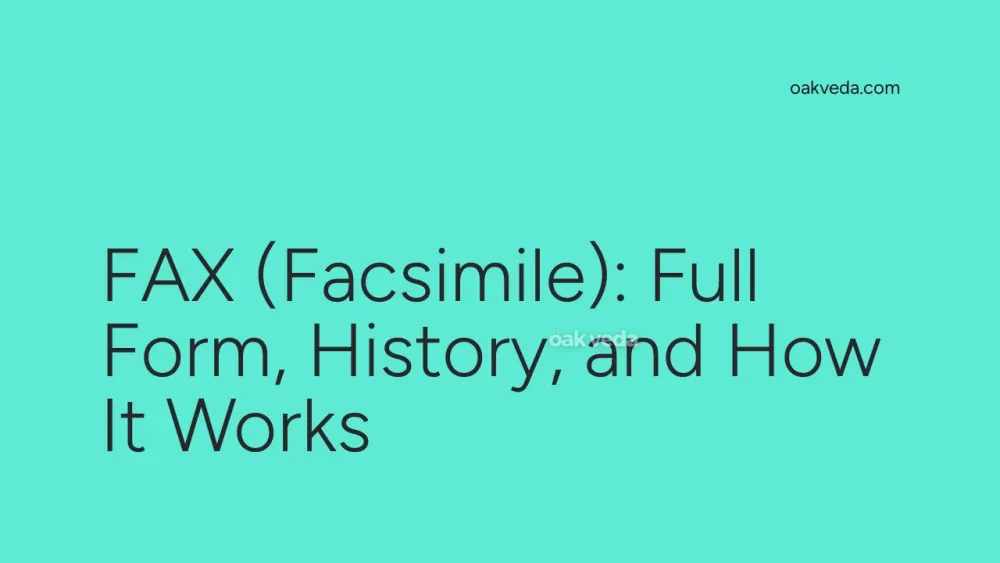
What is the Full Form of FAX?
The full form of FAX is Facsimile. This term originates from the Latin word "fac simile," meaning "make similar." FAX technology has been a cornerstone of business communication for decades, allowing the transmission of document copies over telephone lines.
What is Facsimile?
Facsimile, commonly known as FAX, is a telecommunication technology that enables the transmission and reproduction of printed or graphical material over a telephone network. It involves scanning a document, converting it into a bitmap image, and transmitting it as audio-frequency tones to a receiving device, which then reconstructs and prints the image.
Origin and Development of Facsimile
The history of facsimile technology spans nearly two centuries:
- 1843: Scottish inventor Alexander Bain patented the "Electric Printing Telegraph," laying the foundation for fax technology.
- 1850s: Frederick Bakewell improved upon Bain's invention, creating an early telefax machine.
- 1861: Italian physicist Giovanni Caselli invented the "Pantelegraph," the first commercially used fax machine.
- 1960s-1980s: Fax technology gained widespread adoption in business environments.
- 1980s-1990s: The introduction of computer-based fax systems and fax modems revolutionized the technology.
How does Facsimile work?
The facsimile process involves several key steps:
- Scanning: The sending fax machine scans the document, converting it into a digital image.
- Encoding: The digital image is converted into a series of audio tones.
- Transmission: These tones are transmitted over telephone lines.
- Decoding: The receiving fax machine interprets the audio tones.
- Printing: The decoded image is printed on paper at the receiving end.
Types of Facsimile Systems
- Analog Fax Machines: Traditional standalone devices that use analog signals for transmission.
- Digital Fax Machines: More advanced systems that convert documents to digital format before transmission.
- Computer-based Fax: Software that allows computers to send and receive faxes using a fax modem.
- Internet Fax (eFax): Services that enable faxing via email or web interfaces, eliminating the need for a physical fax machine.
Functions of Facsimile
Facsimile technology serves several crucial functions:
- Document Transmission: Quickly sending copies of documents over long distances.
- Legal Verification: Providing a means of transmitting signed documents.
- International Communication: Facilitating the exchange of written information across borders.
- Image Transfer: Sending graphical content, such as diagrams or photographs.
Applications of Facsimile
Despite the rise of email and digital communication, fax remains relevant in various sectors:
- Healthcare: Transmitting medical records and prescriptions.
- Legal: Sending signed contracts and official documents.
- Government: Communicating sensitive information securely.
- Finance: Transferring financial documents and statements.
- Real Estate: Exchanging property documents and contracts.
Features of Facsimile
Modern fax systems offer several advanced features:
- Auto-dialing: Storing frequently used fax numbers for quick access.
- Broadcasting: Sending the same document to multiple recipients simultaneously.
- Scheduled Transmission: Programming faxes to be sent at specific times.
- Error Correction: Detecting and correcting transmission errors.
- Encryption: Securing sensitive information during transmission.
Benefits of Facsimile
Facsimile technology offers several advantages:
- Legal Acceptance: Faxed signatures are often legally recognized.
- Universality: Fax machines are widely available and compatible.
- Simplicity: Easy to use without extensive technical knowledge.
- Security: Direct transmission reduces the risk of interception compared to email.
- Confirmation: Provides immediate confirmation of receipt.
Limitations or Challenges of Facsimile
Despite its benefits, facsimile technology faces several challenges:
- Image Quality: Faxed documents may lose clarity, especially for images or small text.
- Speed: Transmission can be slow compared to modern digital methods.
- Cost: Maintaining fax lines and machines can be expensive.
- Environmental Impact: Paper-based faxing contributes to deforestation and waste.
- Obsolescence: Declining usage as digital alternatives become more prevalent.
Future Developments in Facsimile Technology
While traditional fax usage is declining, the technology is evolving:
- Cloud Fax Services: Integration with cloud storage and management systems.
- Mobile Faxing: Apps that allow faxing from smartphones and tablets.
- AI Integration: Automated document processing and routing.
- Blockchain Fax: Enhanced security and verification using blockchain technology.
FAQs on FAX Full Form
-
Is fax still relevant in the digital age? Yes, fax remains relevant in industries requiring secure document transmission and legal verification.
-
Can I send a fax without a fax machine? Yes, online fax services allow you to send faxes using a computer or smartphone.
-
Are faxed signatures legally binding? In many jurisdictions, faxed signatures are considered legally binding, but it's best to check local laws.
-
How secure is fax transmission? Fax is generally considered more secure than email, but it's not immune to interception. Encryption can enhance security.
-
What's the difference between fax and email? Fax transmits document images over phone lines, while email sends digital data over the internet. Fax is often preferred for legal documents due to its direct transmission and acceptance in many legal contexts.
In conclusion, while the full form of FAX - Facsimile - may seem like a relic of the past, this technology continues to play a crucial role in certain industries. As it evolves to meet modern needs, facsimile technology demonstrates its enduring relevance in the digital age.
You may be interested in:

